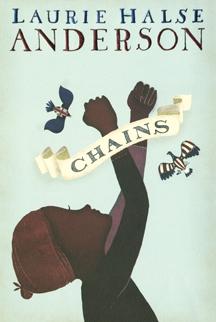Full Text Reviews: School Library Journal - 10/01/2008 Gr 6-10-Set in New York City at the beginning of the American Revolution, Chains addresses the price of freedom both for a nation and for individuals. Isabel tells the story of her life as a slave. She was sold with her five-year-old sister to a cruel Loyalist family even though the girls were to be free upon the death of their former owner. She has hopes of finding a way to freedom and becomes a spy for the rebels, but soon realizes that it is difficult to trust anyone. She chooses to find someone to help her no matter which side he or she is on. With short chapters, each beginning with a historical quote, this fast-paced novel reveals the heartache and struggles of a country and slave fighting for freedom. The characters are well developed, and the situations are realistic. An author's note gives insight into issues surrounding the Revolutionary War and the fight for the nation's freedom even though 20 percent of its people were in chains. Well researched and affecting in its presentation, the story offers readers a fresh look at the conflict and struggle of a developing nation.-Denise Moore, O'Gorman Junior High School, Sioux Falls, SD Copyright 2008 Reed Business Information. - Copyright 2008 Publishers Weekly, Library Journal and/or School Library Journal used with permission. Bulletin for the Center... - 11/01/2008 Isabel has been granted manumission in the will left by her recently deceased owner, but since the will is now far away with a lawyer in Boston and the owner’s nephew is very much at hand in Rhode Island with her, Isabel is still a de facto slave. Sold to the Locktons, a Loyalist New York family, at the onset of the Revolutionary War, Isabel meets another slave, Curzon, who convinces her that spying for the Patriots can be her ticket to freedom. Desperate to free herself and her younger sister from the Locktons, Isabel slips information about Mr. Lockton’s activities to rebel officers, who first promise to help her cause and then back out of their pledge on the grounds that they cannot interfere with local property matters. A new rumor arises among the New York slave community that the Loyalists are the better bet, with their commitment to freeing those who turn against the rebels, but their word proves no better. When Isabel finally realizes that her future is in her own hands, she plans a daring escape that brings at least some hope of freedom for herself, her sister, and the now disillusioned Curzon. The engrossing story is complemented by exceptional end matter—Q&A format with sources for each explanation—making clear that imagining Good Americans vs. Bad British is just as simplistic and erroneous as positing Bad American Slave Holders vs. Good British Anti-Slavers. The political complexities of Isabel’s dilemma never get in the way of a heart-racing story, and the hopeful but uncertain ending leaves readers on a note of realism. EB - Copyright 2008 The Board of Trustees of the University of Illinois. Booklist - 11/01/2008 *Starred Review* In the spring of 1776, Isabel, a teenage slave, and her sister, Ruth, are sold to ruthless, wealthy loyalists in Manhattan. While running errands, Isabel is approached by rebels, who promise her freedom (and help finding Ruth, who has been sent away) if she agrees to spy. Using the invisibility her slave status brings, Isabel lurks and listens as Master Lockton and his fellow Tories plot to crush the rebel uprisings, but the incendiary proof that she carries to the rebel camp doesn’t bring the desired rewards. Like the central character in M. T. Anderson’s Octavian Nothing duet, Isabel finds that both patriots and loyalists support slavery. The specifics of Isabel’s daily drudgery may slow some readers, but the catalogue of chores communicates the brutal rhythms of unrelenting toil, helping readers to imagine vividly the realities of Isabel’s life. The story’s perspective creates effective contrasts. Overwhelmed with domestic concerns, Isabel and indeed all the women in the household learn about the war from their marginalized position: they listen at doors to rooms where they are excluded, and they collect gossip from the streets. Anderson explores elemental themes of power (“She can do anything. I can do nothing,” Isabel realizes about her sadistic owner), freedom, and the sources of human strength in this searing, fascinating story. The extensive back matter includes a documented section that addresses many questions about history that readers will want to discuss. - Copyright 2008 Booklist. Loading...
|



